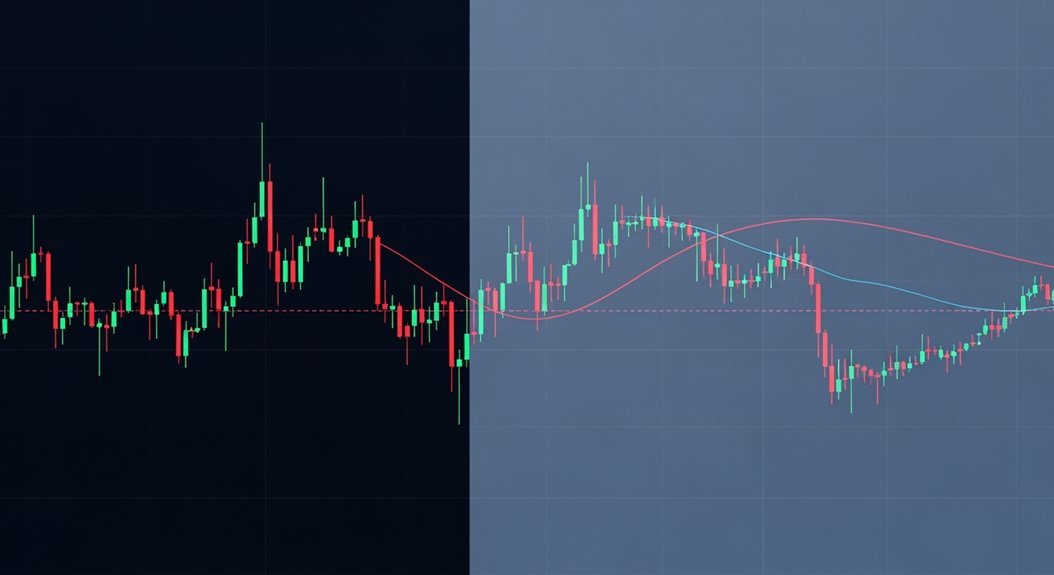Order blocks are specific price zones where institutional traders place large orders, creating concentrated areas of buying or selling pressure. These zones form when smart money breaks massive trades into smaller chunks to avoid market disruption. They appear as tight candlestick clusters before significant price movements and function as informal support or resistance levels.
Unlike traditional support and resistance, order blocks pinpoint exact candles with institutional activity, often triggering sharper reversals and more predictable price reactions when retested later.
Order Block Formation and Key Characteristics

When institutional traders need to move massive amounts of capital, they can’t simply dump everything into the market at once without triggering catastrophic price swings that work against them. Instead, they break large orders into smaller chunks. Execute gradually. Wait for liquidity.
Smart money moves in shadows—breaking massive positions into whispers to avoid market earthquakes that would destroy their own profits.
This creates order blocks—specific price zones where institutions accumulate or distribute positions. Think of them as institutional footprints left behind on charts.
These blocks appear as tight candlestick clusters before major moves. They mark areas of heightened activity where big money operated. When price revisits these zones, it often reacts strongly. Pauses. Reverses. Sometimes breaks through with conviction.
Bullish order blocks form when institutions start buying during downtrends. They’ve spotted value. Bearish blocks emerge when smart money begins selling into uptrends. Both types function as informal support or resistance levels.
The key insight? Order blocks reveal where institutions placed their bets. That information carries weight. These zones become potential turning points where price action often shifts direction as the market encounters concentrated institutional interest. Order blocks can absorb available market liquidity, creating imbalances that drive significant price movements. However, traders must understand that past performance doesn’t guarantee future results when using these levels for trading decisions.
How to Identify Order Blocks on Trading Charts
Spotting order blocks requires a systematic approach that cuts through chart noise to reveal institutional activity. Traders start by hunting for significant momentum moves. Sharp directional surges that follow consolidation periods. These create the foundation.
Next comes pinpointing the last opposing candle. Before a bullish breakout, find that final bearish candle. Before a bearish plunge, locate the last bullish one. This candle marks where institutions loaded up.
The order block zone stretches from this candle’s high to low. Simple boundaries. Clear zones.
Higher timeframes work best. Daily and weekly charts filter out noise. They reveal genuine institutional footprints rather than retail chaos. Lower timeframes create false signals.
Confirmation comes through subsequent price reaction. Strong directional moves away from the zone validate the block. Volume spikes help too. Clean price action with minimal erratic movements often signals genuine institutional involvement.
Liquidity zones provide additional context. Order blocks often nest within these broader areas of heavy trading activity. Smart money leaves traces everywhere. These zones frequently cluster around round numbers where institutional orders concentrate. Successful traders incorporate order blocks into their trading plan to avoid emotional decision-making and maintain strategic consistency. Prices often return to test the order block before moving again, creating additional confirmation opportunities.
Trading Strategies Using Order Block Analysis
Identifying order blocks sets the foundation, but profitable trading demands strategic execution. Successful traders combine order blocks with break of structure (BOS) signals to maximize probability. When bullish BOS aligns with bullish order blocks, institutional momentum confirms the setup.
Change of Character (Choch) patterns add another layer. These signals indicate trend reversals or weakening, making order blocks more reliable for reversal trades. Smart money often targets liquidity zones above highs or below lows. Overlaying these with order blocks creates powerful confluence.
| Strategy Component | Application |
|---|---|
| BOS + Order Blocks | Trend continuation trades |
| Choch + Order Blocks | Reversal setups |
| Liquidity + Order Blocks | High-probability zones |
Risk management remains essential. Stop losses sit just beyond order block boundaries. Position sizing matches setup strength. Additional confirmation—volume spikes, price action patterns—validates entries.
Multiple timeframes enhance precision. Higher timeframe liquidity combined with lower timeframe order blocks improves accuracy. Higher timeframe order blocks generally provide stronger signals due to increased institutional participation. Untested order blocks provide the most reliable entry opportunities since institutional orders remain unfilled at these levels. Patience pays. Wait for price retesting before execution. Traders should avoid fake zones by ensuring proper confluence exists before entering positions.
Order Blocks Vs Traditional Support and Resistance Levels

Precision separates order blocks from traditional support and resistance levels like a scalpel from a sledgehammer. Order blocks pinpoint specific candles where institutional traders executed large orders. Traditional S&R draws broader zones from historical highs and lows.
The difference matters. Order blocks reveal where smart money operates—banks, hedge funds, major institutions. S&R levels show general market reactions from all participants, including retail traders. One tracks elephant footprints. The other measures the entire herd.
Identification methods diverge sharply. Traders spot order blocks by analyzing specific candle formations—the last bearish candle before a bullish surge, or vice versa. They confirm these zones using Fair Value Gaps and volume analysis. Traditional S&R requires simpler visual recognition of repeated price bounces.
Price action responds differently too. Order blocks often trigger sharp reversals due to clustered institutional orders. S&R levels may cause consolidation or gradual reactions. Order blocks predict institutional behavior. S&R reflects historical patterns. Order blocks function as support and resistance levels but with institutional precision behind their formation. Order blocks create market imbalances that lead to more predictable price movements than traditional support and resistance levels.
Frequently Asked Questions
What Timeframes Work Best for Order Block Trading Strategies?
Higher timeframes like H4, daily, and weekly charts deliver the most reliable order block signals. These reflect stronger institutional participation and offer better risk-to-reward setups. Lower timeframes work for entry refinement after identifying blocks on higher charts.
The 15-minute and 5-minute timeframes help pinpoint exact entry levels within larger zones. Multi-timeframe analysis combining both approaches maximizes accuracy and reduces false signals considerably.
How Long Do Order Blocks Typically Remain Valid in the Market?
Order block validity varies dramatically based on timeframe and market conditions. Higher timeframes like daily or weekly charts can remain valid for weeks. Shorter timeframes may only last hours. Low volatility extends their lifespan as price repeatedly tests zones. High volatility or trending markets breach them quickly. Economic events can instantly invalidate blocks. Institutional interest determines ultimate duration.
Can Order Blocks Be Used Effectively in Cryptocurrency Trading?
Order blocks work effectively in cryptocurrency trading when properly applied. Institutional activity creates significant support and resistance zones that traders can exploit. The high volatility amplifies their impact, creating profitable opportunities. However, crypto’s decentralized nature makes institutional detection harder than traditional markets. False breakouts occur frequently. Traders need confirmation techniques and solid risk management. Success requires combining order blocks with additional analysis tools.
What Position Sizing Should Traders Use When Trading Order Blocks?
Traders should risk 0.5% to 2% of capital per order block trade. Position size must adjust based on stop-loss distance and market volatility. Use ATR to scale positions – smaller sizes in high volatility, larger in stable conditions. Studies show 1-1.5% fixed fractional risk yields consistent profits. Stop losses go just beyond order block boundaries. Diversify across multiple signals. Reserve capital for drawdowns during testing phases.
How Do News Events Affect the Reliability of Order Blocks?
News events greatly undermine order block reliability through sudden volatility spikes. Price often breaks through these zones during major announcements, treating them as flexible levels rather than solid support or resistance. Institutional traders alter their usual accumulation patterns around news, creating market noise that obscures order block clarity. Technical confirmation signals become unreliable. False breakouts increase. Traders must adjust strategies accordingly during high-impact events.



